Content
Wilhelm Bauer´s 150th anniversary of death
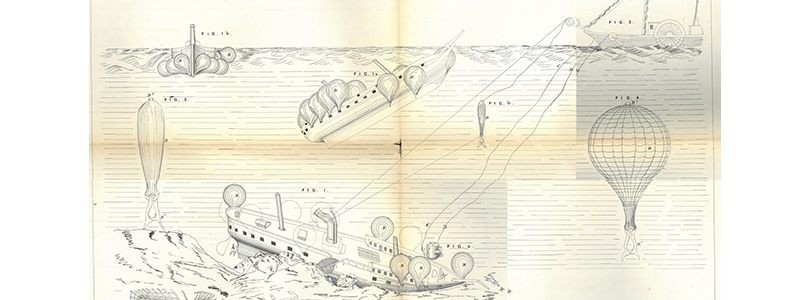
GB590 (1860)
The first submarine
Far away from the sea lies the home of the first German submarine builder: Wilhelm Bauer was born in Dillingen on the Danube. He not only built the world's oldest surviving submarine, the "Brandtaucher", but was also a pioneer in wreck salvage.
Sebastian Wilhelm Valentin Bauer, born on 22 December 1822, was a trained wood turner who had inventing in his blood. In 1849, he took part in the Schleswig-Holstein War as a soldier in the Bavarian auxiliary corps. There he came up with the idea of inventing a weapon that could attack under the surface of the sea.
Legendary predecessors
Submarines were not a new idea. Among its predecessors was, for example, the "moving submersible" that Cornelis Jacobszoon Drebbel presented to the English King Charles I in 1626. It is said to have worked, but we know little about this construction today. The German engineer Jakob Chrysostomus Praetorius designed the "Steinhuder Hecht" in 1762, which is said to have dived in the Steinhuder Meer. The "Hecht" (luce) would thus have been the first German submarine, but the sources are uncertain - and the Steinhuder Meer is not deep enough for diving, anyway…
In the American War of Independence, David Bushnell's "Turtle" was used unsuccessfully against an English ship in 1776. Unlike most of its predecessors, it had real underwater propulsion and was moved by hand crank over screws. And even Napoleon is said to have been interested in the "Nautilus", which the American Robert Fulton constructed in 1801.
The seal as inspiration
How much Wilhelm Bauer could have known about these predecessors is unclear. In any case, he went his own way and studied the natural movements of the seal in Jutland, which he took as a model for his construction. In fact, the shape of his boat resembled a fattened walrus, which is why it was also called the "iron seal".
Back home in Bavaria, Bauer presented his idea to a military commission, but they were not interested (for lack of access tot he sea?). So he went back north, joined the Schleswig-Holstein army and convinced the Navy Ministry of his plans. Bauer then destroyed his demonstration model - he was afraid of imitators, because at that time there was no German patent office to protect inventions. Bauer was ordered to Kiel to build his submarine, but did not receive sufficient financial support. He had to find additional funding.
Fatal compulsion to save money
Together with the engineer August Howaldt from the machine factory and iron foundry Schweffel & Howaldt, he set to work. But the lack of money condemned the "Brandtaucher" to failure practically from the start. In order to save costs, Bauer and Howaldt had to, among other things, halve the wall thickness of the hull, increase the distance between the frames and install a sliding weight made of cast iron for stabilisation instead of the planned trim and ballast tanks.
The "Brandtaucher" had a crew of three. The propeller was driven by two man-sized treadwheels. The Schwengel pumps, with which the ballast water was let in and pumped out directly into the bilge of the hull, were also hand-operated.
The design got its name because it was intended to be used to attach an incendiary bomb or limpet charge weighing about 50 kilos to enemy ships. For this purpose, the hull had small windows and two holes with integrated rubber gloves with which the bomb was to be attached (the first torpedo was not developed until 1865, by Robert Whitehead and Giovanni Luppis).
Disaster in the Förde
Initial swimming tests were successful, but then the boat sank due to an operating error. It was lifted and refloated for serious testing. Together with the carpenter Friedrich Witt and the blacksmith Wilhelm Thomsen, Wilhelm Bauer undertook the first (and last) test trip with the "Brandtaucher" in Kiel harbour on 1 February 1851.
The first few minutes went well, but when Bauer headed for the deepest part of the harbour basin to dive, the consequences of the need to economise became apparent: water entered, the ballast weight slipped, the diving process got out of control. The boat sank stern first to the bottom of the Kieler Förde.
At a depth of about 15 metres, Bauer and his companions kept their nerve. They waited for hours until enough water had entered the boat and the pressure was equalised to allow the hatches to be opened. When the helpers and spectators on the shore had long given up all hope, the three diving pioneers climbed out of the wreck and shot to the surface.
The first German submarine seemed lost. Bauer built a new model in 1852 for advertising purposes, which can be seen today in the ![]() Deutschen Museum in Munich right next to the DPMA. Years later, the "Brandtaucher" was discovered by chance during dredging of the Kiel harbour basin and lifted in 1887. Today, it is on display in the Military History Museum of the German Armed Forces (
Deutschen Museum in Munich right next to the DPMA. Years later, the "Brandtaucher" was discovered by chance during dredging of the Kiel harbour basin and lifted in 1887. Today, it is on display in the Military History Museum of the German Armed Forces (![]() MHMBW) in Dresden.
MHMBW) in Dresden.
Patents in London
Bauer drew his lessons from the disaster, did not give up and tried to get royal support for his ideas. At the invitation of Albert, Queen Victoria's husband, he went to London. In the United Kingdom, in contrast to the German countries, there had long been a functioning system of intellectual property protection. Wilhelm Bauer knew how to take advantage of this and registered his inventions with the English patent office from now on. The first patent, filed on 25 May 1853, was ![]() GB1281 (1853): "Vessel to be used chiefly under water, and apparatus for propelling, balancing and steering the same". In principle, this is a concise description of the "Brandtaucher".
GB1281 (1853): "Vessel to be used chiefly under water, and apparatus for propelling, balancing and steering the same". In principle, this is a concise description of the "Brandtaucher".
Bauer designed a new diving boat in London. But there were legal dissonances around the planning for the construction. Bauer then threatened to offer his invention to Russia. This got him into a lot of trouble, because both countries were fighting against each other in the Crimean War. Bauer had to flee England. The London shipyard then built a submarine without him. It is said to have sunk with all hands during the test run.
Submarine for Russia
Bauer now went to Russia, where he was welcomed with open arms. His new submarine was called "Le Diable de Marin" ("Sea Devil") and was built in St Petersburg in 1855.
This construction was a success. This time, there was no skimping on materials. Although the "Sea Devil" was still operated by muscle power (by 12 sailors), it had a solid thick iron hull, was twice as big as the "Brandtaucher", could sink and rise independently and had a diving chamber to exit under water. After the first trials in the naval port of Kronstadt, the " Sea Devil " is said to have successfully completed 133 dives before sinking (probably due to an operating error). It is said that the crew was rescued and the boat lifted, but what became of it is unknown.
Salvaging sunken ships with balloons
The Tsar appointed Bauer as Imperial Submarine Engineer and commissioned him to salvage a sunken warship. This assignment resulted in two inventions, which Bauer got patented in the UK in 1860: ![]() GB590 (20,86 MB),, "Apparatus for diving, and raising and lowering heavy bodies", and
GB590 (20,86 MB),, "Apparatus for diving, and raising and lowering heavy bodies", and ![]() GB1716, "Diving bell". The detailed drawings in patent specification GB590 provide a fascinating insight into his technical ideas.
GB1716, "Diving bell". The detailed drawings in patent specification GB590 provide a fascinating insight into his technical ideas.
Among other things, Bauer designed a diving chamber that could be used to a depth of 500 feet and a salvage system using iflatable balloons. But Bauer again got into conflict with the authorities. In 1858, he left Russia and returned to Munich.
The raising of the "Ludwig“
A few years later, he was to be able to test his salvage system in practice, namely on Lake Constance. There, the "Ludwig" had sunk on 11 March 1861. She had been the first iron steamer on the lake, built in Manchester in 1837 and transported in individual parts to Lindau for final assembly. This "Ludwig" had collided with the "Stadt Zürich" in a storm. Incidentally, the accident with 13 fatalities led to the introduction of the international position lantern system for ships that is still in use today - white top light, green lamp on starboard, red on port.
Wilhelm Bauer succeeded in lifting the "Ludwig" from a depth of around 11 metres with his balloon system in 1863. She was refloated, went on a voyage under a new name, later sank again in a storm, was lifted again and eventually scrapped.
The emergence of a dangerous weapon
At that time, the development of submarines was gaining momentum worldwide. In 1864, during the American Civil War, the „CSS H. L. Hunley“ became the first submarine to sink an enemy ship in combat (and got missing in action herself). Submarines slowly became the dangerous weapon they still are today.
Despite the spectacular success with the raising of the "Ludwig", Bauer's career did not really take off again. He briefly entered Prussian service, but returned to Bavaria and continued to experiment. For example, he conducted underwater shooting experiments at Lake Starnberg and developed devices for laying cables under water.
Health problems and strokes of fate overshadowed his last years. A 150 years ago, on 20 June 1875, the far-travelled engineer and submarine pioneer died in Munich.
Similar to the ‘Brandtaucher’, another revolutionary submarine spent a long time at the bottom of the sea before it was raised and finally became a museum object: U2540 type XXI. This design, which was introduced by the German Kriegsmarine in 1944, was consistently constructed for travelling under water and therefore, unlike its predecessors, was not merely a submersible torpedo boat, but the first real submarine. The boat was sunk by its own crew off Flensburg in May 1945, raised in 1957 and used by the navy until 1982. It was named after the pioneer of German submarines. Today, the ‘Wilhelm Bauer’ is a ![]() museum ship in Bremerhaven.
museum ship in Bremerhaven.
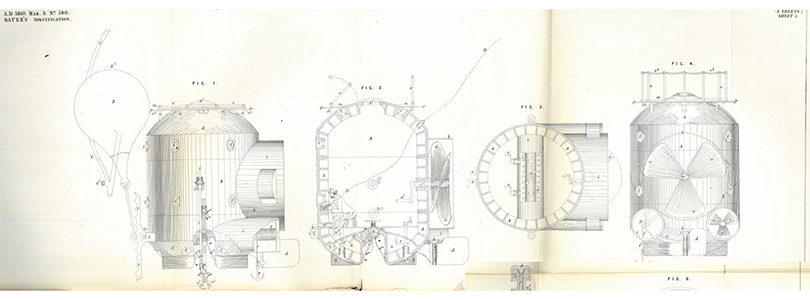
GB590 (1860)
Text: Dr. Jan Björn Potthast; Pictures: DEPATISnet / Archiv DPMA, unkonwn author / Public domain via Wikimedia Ccommons, Pudelek CC by SA 3.0 via Wikimedia Commons, unknown author / Public domain via Wikimedia Commons Bildquelle Deutsches Museum, via Wikimedia Commons
Last updated: 10 December 2025

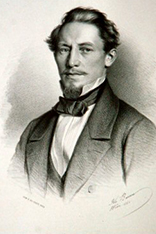
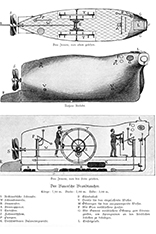
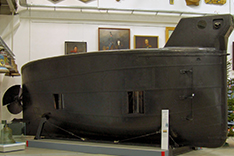
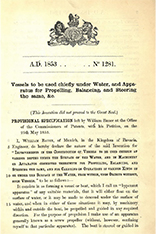
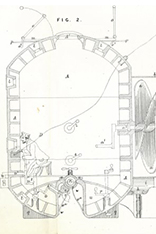
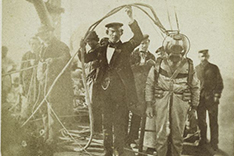
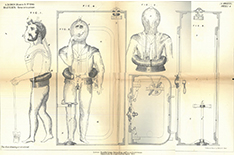
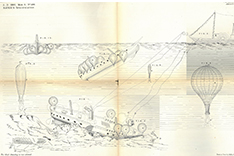
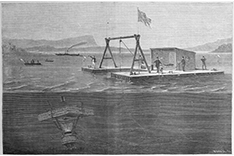
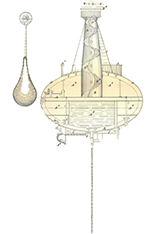
Not only protecting innovations
Social Media